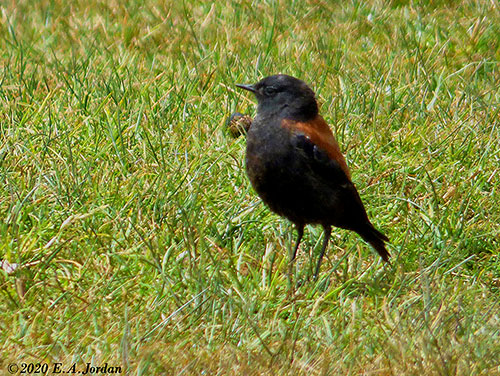
Fr: Lessonie noire
Ang: Austral Negrito - Patagonian Negrito
All: Patagoniensporntyrann
Esp: Negrito Austral
Ita: Negrito australe
Nd: Roodrugnegrito
Sd: patagoniennegrito
Photographers:
Jean-Claude Billonneau
Photographe-témoin de la Beauté du Monde
Eduardo Andrés Jordan
MIS AVES – AVES DE ARGENTINA
Dubi Shapiro
Dubi Shapiro Photo Galleries
Text by Nicole Bouglouan
Sources:
HANDBOOK OF THE BIRDS OF THE WORLD Vol 9 - by Josep del Hoyo - Andrew Elliot - David Christie - Lynx Edicions - ISBN: 8487334695
BIRDS OF SOUTH AMERICA – Passerines - by Robert S. Ridgely and Guy Tudor – HELM Field Guides – ISBN: 9781408113424
First record of the Austral Negrito (Aves: Passeriformes) from the South Shetlands, Antarctica
Arthur Grosset's Birds (Arthur Grosset)
Wikipedia, the free encyclopaedia
Austral Negrito or Patagonian Negrito
Lessonia rufa
Passeriformes Order – Tyrannidae Family
INTRODUCTION:
The Austral Negrito is a South American species found in Chile and Argentina to Tierra dl Fuego. It moves northwards after the breeding season to spend the winter.
It is often observed near the coast or lake shores and other types of wetlands. But it also frequents the open areas with short grass where it forages for small insects caught on the ground or in the air. The long legs and the long, straight hind claw are well-adapted to the foraging behaviour in marshy habitats.
This species nests on the ground where it is protected by the vegetation, and also on cliff ledges. The female alone performs the nesting duties.
The Austral Negrito is described as “fairly common” and is not considered globally threatened at the moment.

DESCRIPTION OF THE BIRD:
Biometrics:
Length: 11,5 – 12,5 cm
The Austral Negrito male adult has black plumage and contrasting rufous-chestnut back.
The short, slender bill is black.
The eyes are dark brown.
The long legs and the feet are black, the latter showing a very long hind claw.
The adult female is much duller. She has dull, rufous-brown back and scapulars. Upperwing and tail are dark brown. The outer web of the outermost rectrices is whitish.
The underparts are buffy white, with breast and body sides streaked greyish-brown, whereas flanks and belly are buff and the vent is whitish. We can see a small cinnamon patch on the underwing.
The juvenile resembles female, but with more rufescent back. The adult plumage appears about six months later.
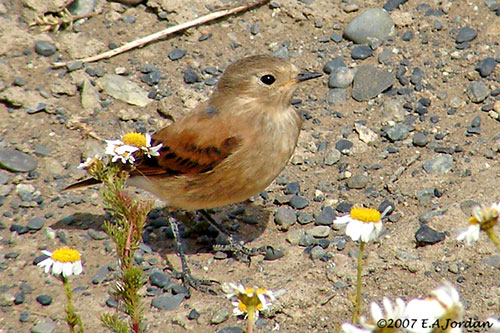
RANGE:
The Austral Negrito breeds in C Chile and C Argentina to Wollaston Islands near Cape Horn.
After breeding, it moves 1,500-2,000 km north to spend the winter in N Chile, S Bolivia, Argentina, Paraguay, SE Brazil and Uruguay.
But this species has also been reported from the Falkland Islands and the South Georgia - South Sandwich Islands territory, and also the South Shetland Islands.
HABITAT:
The Austral Negrito frequents the wet areas such as freshwater lakes and salt marshes. It is usually found in open areas with short grass or bare soil, often near water, coasts, lagoons and beaches.
The species is present below 1,000 metres of elevation, but locally, it may reach up to 2,000 metres.
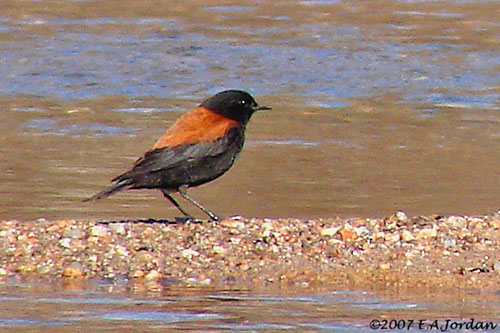
CALLS AND SONGS: SOUNDS BY XENO-CANTO
The Austral Negrito is known to be quiet and usually silent, but we can hear a short twitter “chip” used as contact call.
When alarmed, the bird gives a repeated “tjit-tjit”.
BEHAVIOUR IN THE WILD:
The Austral Negrito is an active insect-eater. The small insects are caught by running about on the ground with short, restless bursts. It also performs short sallies from perches and flutters briefly into the air while pursuing a prey. It tends to flick both wings and tail when perched on bushes, rocks or fences.
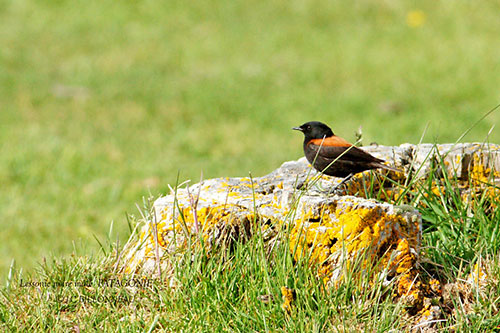
It can be seen following livestock in grassy fields, in search of flushed insects.
The diet includes acarids, springtails (Friesea grisea of family Neanuridae), and Dipteran such as the flightless Antarctic midge (Belgica Antarctica). It may also feed on algae (Prasiola crispa), depending on the area.
Outside breeding season, the Austral Negrito often forms small, loose flocks.
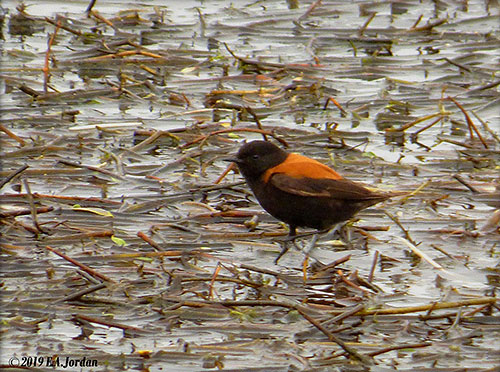
At the beginning of the breeding season, some displays are observed. The male can be seen fluttering into the air, 10-15 metres above the ground. We can suggest that the conspicuous bright rufous-chestnut back is enhanced by adapted postures during the displays.
The species nests on the ground under the vegetal cover, and also on cliff ledges. The female alone builds the nest and cares for the chicks.
The Austral Negrito is a strongly migratory species and moves over 1,500-2,000 km north to winter.
As the male does not take part in nesting duties, it leaves the breeding grounds while the female cares for the fledglings. They migrate in flocks, apparently entirely made up of one sex.
Travelling by vessel cannot be excluded, especially for the birds flying between King George Island and the nearest breeding places in Tierra del Fuego (900 km). Usually, the Austral Negrito migrates over land, and no passage over the oceans has been reported. There are some records at sea in the Antarctic waters.
The Austral Negrito is agile in flight while performing the fluttering aerial displays, or while sallying from perches to catch prey.
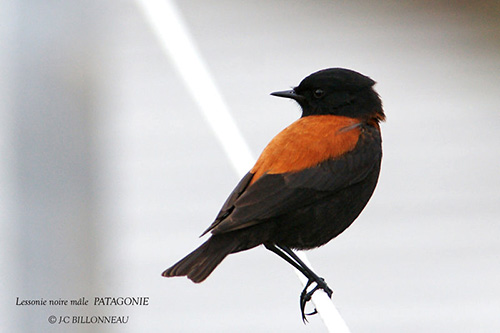
REPRODUCTION OF THIS SPECIES:
The breeding season takes place from September to November in Chile, from October to January on Tierra del Fuego y in Argentina, and December in Bolivia.
Following some courtship displays, the copulation occurs. Then, the female builds a small, open, cup-shaped nest made of twigs, small branches and roots. The cup is lined with feathers. It is often built on the ground, below overhanging vegetation, and occasionally on cliff ledge.
The female lays 2-4, usually 3 white eggs with scattered dark spots. No more information.
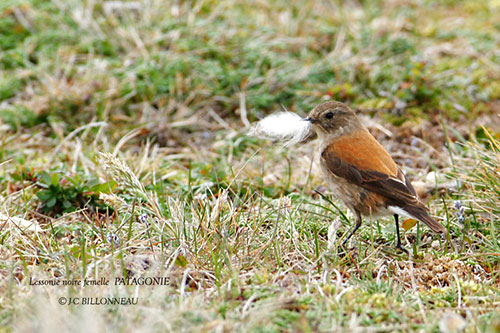
The male leaves the breeding grounds well before the female as it does not take part in nesting duties. The female still cares for the young until they fledge. Once they are able to fly over long distances, both young and female migrate northwards to winter.
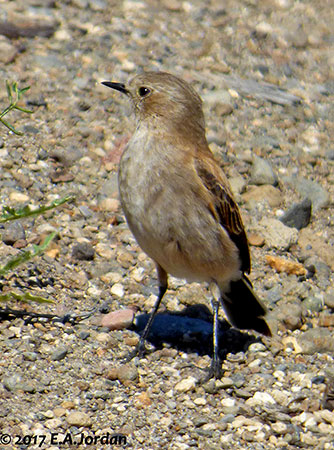
PROTECTION / THREATS / STATUS:
The Austral Negrito is described as fairly common to locally common.
In the southern part of the breeding range, the population is suspected to be increasing in numbers.
The species is present in several national parks along the Patagonian Andes.
The Austral Negrito is currently evaluated as Least Concern.
